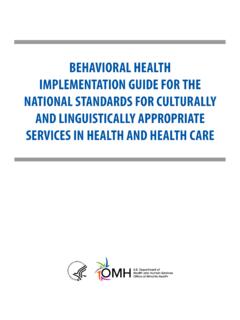Transcription of An Introduction to Racial Equity Assessment Tools
1 An Introduction to Racial Equity Assessment Tools Governing For Racial Equity March 2014. Terry Keleher Race Forward About Race Forward Race Forward advances Racial justice through research, media, and practice. Race Forward brings systemic analysis and an innovative approach to complex race issues to help people take effective action towards Racial Equity . Race Forward publishes the daily news site Colorlines and presents Facing Race, the country's largest multiracial conference on Racial justice. Racial Justice Racial Justice is the systemic fair treatment of all people that results in equal opportunities and outcomes for everyone.
2 Implicit Bias Implicit biases are pervasive People are often unaware of their implicit bias Implicit biases predict behavior People differ in levels of implicit bias -- Project Implicit ( ). Examples of Implicit Bias Doctors are less likely to prescribe life-saving care to blacks. Managers are less likely to call back or hire members of a different ethnic group. NBA referees are more likely to subtly favor players with whom they share a Racial identity. Teachers call on boys more often than girls. Source: Racial bias examples from http://. Implicit Bias is: Individual AND Institutional A lot of Racial inequities occur without intention or malice.
3 It does not require racists. Implicit bias helps explain how racism can be subtle in appearance but significant in impact. In institutions, the bias of individuals is routinely replicated through collective decisions and actions. It becomes compounded unless it's consciously counteracted. Implicit Bias offers the idea that discrimination and bias are social, rather than individual issues, and that we can thus all participate in promoting equality.. --American Values Project Implicit Bias and Public Policy Most policies are facially neutral (race silent) but not racially neutral they have negative or positive Racial impacts.
4 Negative Racial impacts may or may not have been intentional. Positive Racial impacts often require intentionality. When Racial impacts are not consciously considered during the lawmaking/decision-making process, there is more likelihood that negative Racial impacts will result-- implicit bias is the default. Choice Points: The Crossroads to Change Choice Points Choice points are decision-making opportunities that influence outcomes. The cumulative impacts of many small choices can be as significant as the impacts of big decisions. When we're conscious of choice points and the related impacts, we're less likely to replicate implicit bias and the status quo, and we open new possibilities for equitable change.
5 Choice Points: Examples Personal Institutional Consumer decisions: where to Planning: what to change and shop, what to buy, or boycott? prioritize in programs/workplans? Volunteer work: what causes to Budgeting: what items to get involved in? prioritize, add or cut? Charitable contributions: what Personnel: who to hire, retain, organizations to support? promote, or develop as leaders? Socializing: who to spend time Policy Development: what to with? propose or modify? Voting: which candidates or Practices: routines/habits to causes to support? continue, change, or cut?
6 Using Choice Points: Organizational Example Citizen Action of New York (CANY) has adopted a standard set of questions to consider when analyzing social issues they want to address. This helps them think about how different Racial groups are affected and whether to explicitly address racism in their framing of the issue. This deliberate practice serves as an Equity prime a reminder that evokes consideration and consciousness of Racial /gender impacts and Racial /gender Equity during an important choice point; thereby helping to counteract unconscious bias. Choice Points in the Criminal Justice System The criminal justice system has many decision-making points and decision-makers where discretion is exercised.
7 For a single defendant, these biases may surface for various decisions makers repeatedly in policing, charging, bail, plea bargaining, pretrial motions, evidentiary motions, witness credibility, lawyer persuasiveness, guilt determination, sentencing recommendations, sentencing itself, appeal, and so on. Even small biases, at each stage may aggregate into a substantial effect. -- UCLA law professor Jerry Kang To change an entire system, we have to examine how decisions are made throughout the system, at every choice point, by every decision-maker. Using Choice Points to advance Equity and Inclusion 1.
8 Where are the decision-making points that affect outcomes? 2. What decisions/actions may be reinforcing the status quo, implicit bias and current inequities? 3. What alternative action options could produce different outcomes? 4. Which action will best advance Equity and inclusion? 5. What reminders, supports and accountability systems can be structured into routine practices to keep Equity as a high priority? Cultivating Equity Mindfulness We can choose to create the space and support to act . Consciously Consistently and Courageously on our values. We can practice pushing the pause button to interrupt our patterns, fears and biases.
9 We can develop Equity muscles and memory to override old habits and responses. We can learn to prime ourselves and others to take mindful action. Pair & Share: Using Choice Points 1. Identify a choice point: What is a choice point in your own work where you have some influence on a decision or course of action that may affect Racial /gender outcomes? 2. Generate some options: For that choice point, identify some alternative actions that could lead to different and more equitable outcomes. 3. Select a new course of action: Decide which option could leverage the most equitable change.
10 Institutionalizing Racial Equity Implicit Bias Explicit Equity Unaware of choice points Builds in decision-making guides that evoke consideration of Equity Exclusive of stakeholders Fosters active engagement and empowerment of stakeholders Not attentive to race, gender, Gives distinct, specific and income and other inequities sufficient attention to key disparities/inequities Ignores barriers to access Supports and implements strategies to remove barriers Does not consider Racial impacts Systematically analyzes potential impacts on disadvantaged groups Explicit Equity ( Equity -Mindedness ).

